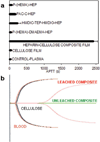Ionic liquid-derived blood-compatible composite membranes for kidney dialysis
- PMID: 16637031
- PMCID: PMC4129660
- DOI: 10.1002/jbm.b.30542
Ionic liquid-derived blood-compatible composite membranes for kidney dialysis
Abstract
A novel heparin- and cellulose-based biocomposite is fabricated by exploiting the enhanced dissolution of polysaccharides in room temperature ionic liquids (RTILs). This represents the first reported example of using a new class of solvents, RTILs, to fabricate blood-compatible biomaterials. Using this approach, it is possible to fabricate the biomaterials in any form, such as films or membranes, fibers (nanometer- or micron-sized), spheres (nanometer- or micron-sized), or any shape using templates. In this work, we have evaluated a membrane film of this composite. Surface morphological studies on this biocomposite film showed the uniformly distributed presence of heparin throughout the cellulose matrix. Activated partial thromboplastin time and thromboelastography demonstrate that this composite is superior to other existing heparinized biomaterials in preventing clot formation in human blood plasma and in human whole blood. Membranes made of these composites allow the passage of urea while retaining albumin, representing a promising blood-compatible biomaterial for renal dialysis, with a possibility of eliminating the systemic administration of heparin to the patients undergoing renal dialysis.
(c) 2006 Wiley Periodicals, Inc.
Figures





Similar articles
-
Heparin-cellulose-charcoal composites for drug detoxification prepared using room temperature ionic liquids.Chem Commun (Camb). 2008 Oct 28;(40):5022-4. doi: 10.1039/b809791g. Epub 2008 Sep 2. Chem Commun (Camb). 2008. PMID: 18931773
-
Preparation of biopolymer fibers by electrospinning from room temperature ionic liquids.Biomacromolecules. 2006 Feb;7(2):415-8. doi: 10.1021/bm050837s. Biomacromolecules. 2006. PMID: 16471910 Free PMC article.
-
Structure-property relationships of Thai silk-microcrystalline cellulose biocomposite materials fabricated from ionic liquid.Int J Biol Macromol. 2017 Nov;104(Pt A):919-928. doi: 10.1016/j.ijbiomac.2017.06.103. Epub 2017 Jun 27. Int J Biol Macromol. 2017. PMID: 28666828
-
Engineering of sustainable biomaterial composites from cellulose and silk fibroin: Fundamentals and applications.Int J Biol Macromol. 2021 Jan 15;167:687-718. doi: 10.1016/j.ijbiomac.2020.11.151. Epub 2020 Nov 27. Int J Biol Macromol. 2021. PMID: 33249159 Review.
-
Heparin and heparin-like modifications in hemodialysis membranes: Current innovations and future directions.Biotechnol Adv. 2025 May-Jun;80:108527. doi: 10.1016/j.biotechadv.2025.108527. Epub 2025 Feb 6. Biotechnol Adv. 2025. PMID: 39922509 Review.
Cited by
-
Emerging Applications of Nanotechnology in Healthcare Systems: Grand Challenges and Perspectives.Pharmaceuticals (Basel). 2021 Jul 21;14(8):707. doi: 10.3390/ph14080707. Pharmaceuticals (Basel). 2021. PMID: 34451803 Free PMC article. Review.
-
Capillary electrophoresis of complex natural polysaccharides.Electrophoresis. 2008 Aug;29(15):3095-106. doi: 10.1002/elps.200800109. Electrophoresis. 2008. PMID: 18633943 Free PMC article. Review.
-
Application of Advanced Nanomaterials for Kidney Failure Treatment and Regeneration.Materials (Basel). 2021 May 29;14(11):2939. doi: 10.3390/ma14112939. Materials (Basel). 2021. PMID: 34072461 Free PMC article. Review.
-
Immobilization of heparin: approaches and applications.Curr Top Med Chem. 2008;8(2):80-100. doi: 10.2174/156802608783378891. Curr Top Med Chem. 2008. PMID: 18289079 Free PMC article. Review.
-
Flexible energy storage devices based on nanocomposite paper.Proc Natl Acad Sci U S A. 2007 Aug 21;104(34):13574-7. doi: 10.1073/pnas.0706508104. Epub 2007 Aug 15. Proc Natl Acad Sci U S A. 2007. PMID: 17699622 Free PMC article.
References
-
- Amass W, Amass A, Tighe B. A review of biodegrable polymers: Uses, current developments in the synthesis and characterization of biodegradable polyesters, blends of biodegradable polymers and recent advances in biodegradable studies. Polym Int. 1998;47:89–144.
-
- Langer R, Tirrell DA. Designing materials for biology and medicine. Nature. 2004;428:487–492. - PubMed
-
- Modi GK, Pereira BJG, Jaber BL. Hemodialysis in acute renal failure : Does the membrane matter? Semin Dial. 2001;14:318–321. - PubMed
-
- Brieterman-White R. A review of heparin use in hemodialysis and peritoneal dialysis. ANNA J. 1995;22:491–493. - PubMed
-
- Rydberg EJ, Westfall MJ, Nicholas RA. Low molecular weight heparin in preventing and treating DVT. Am Fam Physician. 1999;59:1607–1612. - PubMed
Publication types
MeSH terms
Substances
Grants and funding
LinkOut - more resources
Full Text Sources
Other Literature Sources
Medical

